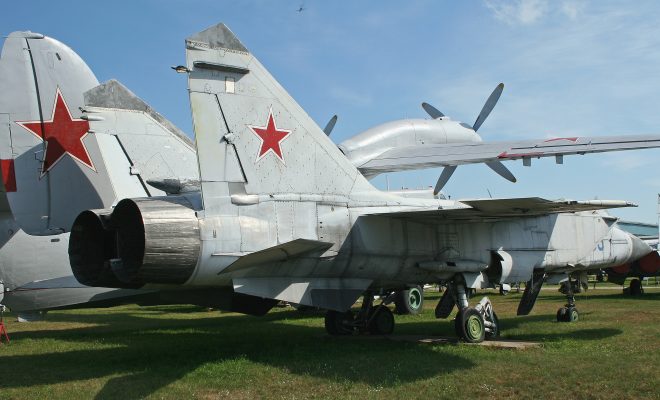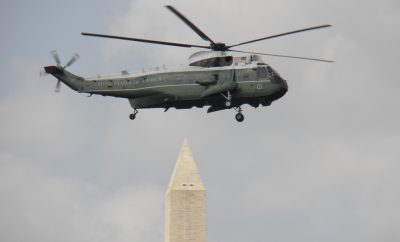 "Mikoyan MiG-31 Foxhound '96 blue'" courtesy of [Alan Wilson via Flickr]
"Mikoyan MiG-31 Foxhound '96 blue'" courtesy of [Alan Wilson via Flickr]
World
How Russia Uses Inflatable Airplanes for Psychological Warfare
Maskirovka is Russian for “something masked,” and it’s also the name of the number one strategy for psychological warfare used by Russia. Recently workers constructed a new piece in the maskirovka collection in a field outside of Moscow–an inflatable fighter jet that looks completely genuine from as close as 300 yards. According to Maria A. Oparina, the director of the company that produces the inflatable decoys, the demand has been growing quickly during the past year. Exactly how many they make is classified, but 80 people are employed full-time and most of them work making inflatable planes or weapons. These decoys are made to confuse and distract enemies, who have to spend valuable time figuring out whether the threat is real or not.
“Nobody ever wins honestly.” On Russia’s inflatable tanks, jets and missile launchers: https://t.co/Aovfj7JxFH pic.twitter.com/Is1VJIJ1k5
— The New York Times (@nytimes) October 12, 2016
The relationship between Russia and the U.S. has deteriorated fast over the past couple of months with the failed ceasefire with Syria, accusations that Russian hackers have tried affecting the election by hacking voter databases, the release of Hillary Clinton emails from Wikileaks, and a cancelled visit from Putin to France.
And on Wednesday, Russian officials said they received an order from Putin to fly home any family members living abroad. They were told to take their kids out of foreign schools immediately, according to local media. This move has people discussing if we’re on the brink of another global war. “This is all part of the package of measures to prepare elites to some ‘big war,’” said political analyst Stanislav Belkovsky.
First Putin Orders Nation Wide Civil Defense Exercise & Now this. What’s Putin Planning & Preparing? https://t.co/UDJEY0M4a1 via @MailOnline
— Bharatavarsha (@T_deserteagle) October 12, 2016
Last month Russia was accused of attacking a humanitarian convoy in Syria, but denied it and blamed terrorists. “Just when we think it cannot get any worse, the power of depravity sinks lower,” UN Secretary General Ban Ki-moon said about the attack. Russia’s denial did not seem very genuine as it, after blaming terrorists, blamed the U.S. and then said the convoy must have caught on fire by itself.
According to Major General Alexander Vladimirov, an authority on maskirovka, the practice is as old as time. We have had to disguise ourselves when hunting ever since the Stone Age. “All human history can be portrayed as the history of deception,” he said. And in Russia, it is common that maps are inaccurate, in case they end up in the hands of a spy. But is that really the same thing as sending fake convoys to take over a territory by scaring opponents off?
Greenwald: In the Democratic Echo Chamber, Inconvenient Truths Are Recast as Putin Plots #Newsweek #KurtEichenwaldhttps://t.co/xfv8YqyauU
— WikiLeaks (@wikileaks) October 11, 2016
One of the most recent occasions when Russia used this tactic was in Crimea two years ago, when masked soldiers were sent there in military vehicles to “volunteer” and do “humanitarian” work. Later it was revealed that most of the trucks were empty. When asked about it on TV, President Vladimir Putin denied that the soldiers were Russian and said that the men could have bought fake uniforms in any ordinary store. But five weeks later when the Russian annexation of Crimea was a fact he admitted that they had indeed been Russian forces.
The concept of maskirovka is to keep the enemy guessing and wondering, and also to include an element of surprise. Examples of Russia’s use of it are easy to find: when soldiers looking like tourists sailed to Syria in 1983 to aid the country in the Lebanese civil war, when a big group of young men flew on a normal Aeroflot flight to Prague but then seized the airport, or when Russia crashed drones over Georgia on purpose in 2008, pretending they were poorly built, until one of them exploded when Georgian officers tried to remove them.
The latest moves by the Kremlin has everyone wondering what is going on and what plans are in the making.








Comments